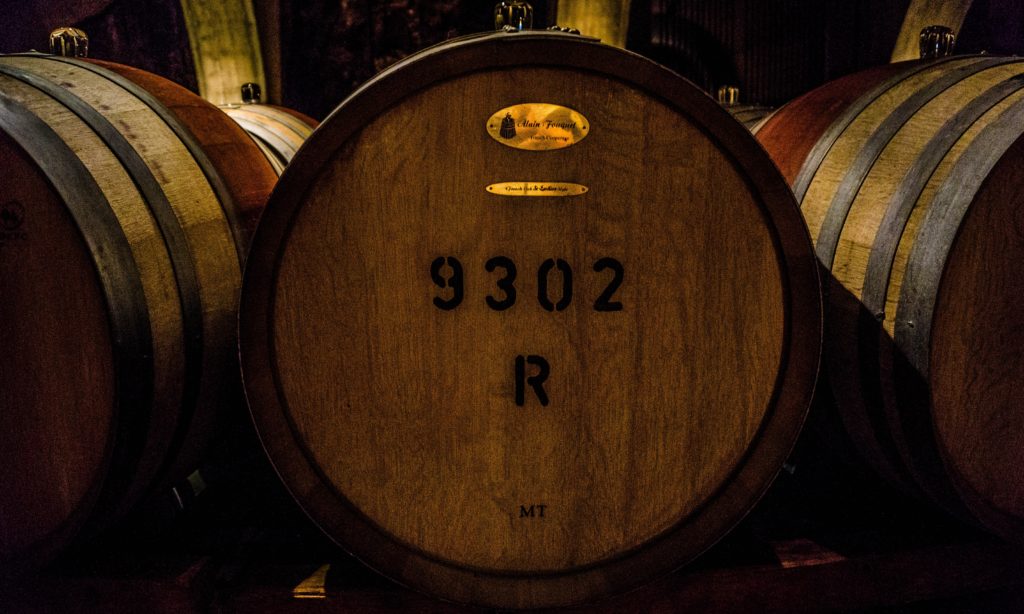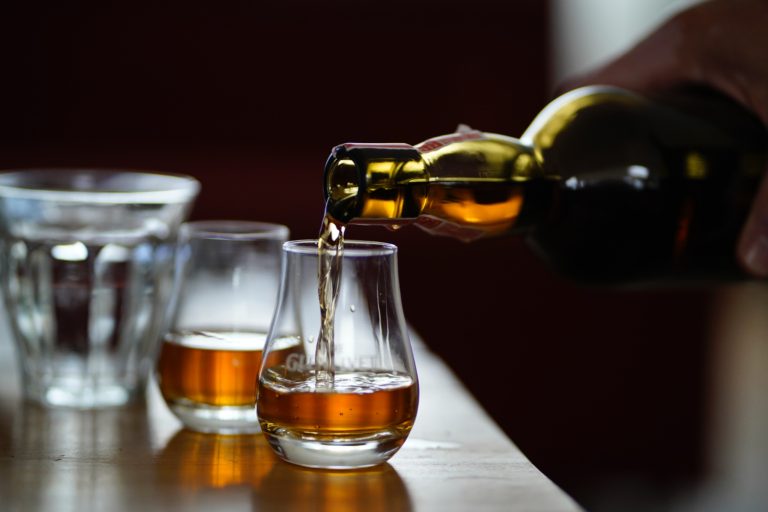One of the reasons I love whiskey is due to it’s rich, brown color. I often find myself just admiring the aesthetics of the whiskey in my glass, winding its way around the ice cubes. To me, the color seems to complement the flavors that I’m tasting and helps to truly enhance my experience. However, I’ve never understood why some whiskeys are darker than others. What is the difference? And what does this tell us about the whiskey itself?
Whiskey comes out of the still clear. Its brown color comes primarily from the barrel that it is aged in. Other factors like the type of wood the barrel is made of, how charred it is, and how long the whiskey has been aged all affect the final color of the whiskey. Some distillers also add a caramel color to adjust their product’s final appearance.
Where does whiskey’s color come from?
Whiskey comes out of the still completely clear. Because of this, all of the color you see in a bottle on the shelf is included either during or after the aging process.
In order to be called whiskey, the distilled spirit must be aged in a wooden cask, most commonly a charred oak cask. It is this wood that traditionally gives whiskey its signature brown color. As the whiskey ages, the liquid expands and contracts with changes in the weather and climate. This expansion forces the whiskey into the wood of the barrel, where the alcohol dissolves flavors, tannins, and pigments from the wood. Inevitably, the whiskey contracts and gets pushed out of the wood, bringing those colors and flavors with it into the rest of the barrel.
After removing the aged whiskey from the cask, some distillers will add a caramel coloring to it. This can serve two purposes: Firstly, adding coloring helps to make sure the whiskey is a uniform color for bottling and leads to a more consistent final product. Secondly, making a whiskey darker can cause slightly higher perceptions of the whiskeys quality.
Why is some whiskey darker?
Obviously, some whiskey is darker than others. While there are many factors that go into how dark a whiskey gets, nearly all of them have to do with how long the whiskey is aged, and the cask that it is aged in. Here is a breakdown:

Aging:
Time in the cask
One of the primary factors in a whiskeys coloring is how long it is aged in the barrel. Whiskey gets darker with age, as it has more time to absorb as much color as possible from its cask. For this reason, the older the whiskey, the darker the dram. If you look up 50 year-0ld whiskeys online, many of those vintages are so dark that they are nearly black.
The Cask Itself:
Type of wood
Nearly all whiskey must be aged in oak casks. However, the different species of oak have different effects on the final color of the spirit. The most commonly used oak varieties are American oak, European oak, and Japanese oak. American oak gives whiskey more of an amber color, while European oak causes more of a light gold. Japanese oak imparts much less color into the whiskey and takes much longer to create a color similar to the other oak varieties. This is one of the reasons that Japanese whiskeys, like Suntory, are often much lighter than other whiskeys you will see on the shelf.
Level of char
Nearly all casks that age whiskey have been charred prior to aging. This means that the distiller burns the inside of the barrel with a torch before filling it. Charring the cask helps to add more color and flavor into the final whiskey, with more char equating to a deeper, darker brown color. Some distillers char their barrels more than others, but nearly all barrels are charred for somewhere between 15 seconds and 1 minute (char levels 1-4). However, distillers can char beyond that if desired.
How used the barrel is
The wood of each barrel only has a finite amount of tannins and pigments to impart into whiskey as it ages. As the barrel gets used, these substances begin to get drained from the wood, into the whiskey itself. Because of this, whiskey that is aged in a new barrel often gets darker faster than one aged in a used barrel, as there is less color for the whiskey to draw from. As a barrel gets used over and over again, the whiskey added to the cask gains less and less color from the aging process, regardless of how long it ages. This leads to some well aged whiskeys being much lighter than other, much younger varieties. This lightness is especially common with scotch, as scotch distillers frequently re-use casks many times, whereas whiskeys like bourbon will be much darker as they are aged in a brand new barrel.
What was the barrel used for previously?
Although aging in a previously used barrel can definitely create a lighter dram than a new barrel, re-using a barrel can also contribute significantly to the final color of the whiskey. Depending on what the barrel was used for before, it might end up giving the whiskey more potent or interesting colors for the final product. Some distillers age their whiskey in port or sherry casks. Given the different colors of these aged wines, this not only gives it a different flavor profile, but can also imbue it with more of a reddish-pink coloring than you usually see in whiskey.
Can whiskey be clear?
While I love the dark brown color of whiskey, it is possible for whiskey to be clear. These are most commonly called “white whiskeys” or “unaged whiskeys”. The regulations for whiskey say that it must be aged, but there is no minimum aging requirement. Therefore, many white whiskies are aged for only a few days before bottling. Once removed from their casks, any color they may have picked up during the aging process is often filtered out, leaving a perfectly clear spirit for sale. You will often find white whiskeys available from new distilleries, as it allows them to release a product early on and gain some funding to maintain their business through the long production process of their aged varieties
Conclusion
In short, don’t judge a whiskey by its color. Whiskey’s brown color primarily comes from the barrel that it is aged in. While darker whiskey may have been aged for longer, this color can also be highly impacted by the type of cask, whether it has been used before, and whether the distiller has added any additional coloring. For this reason, I will continue to appreciate the color, but focus on the taste. Cheers!
Whisky Will’s the name and Scotch is my game! I am obsessed with whiskeys, bourbons, and scotches and love to write about them. Whisky Grotto is my playground where I educate the world about whisky, bartending, and more. So, keep sipping your drink and have a good time!

